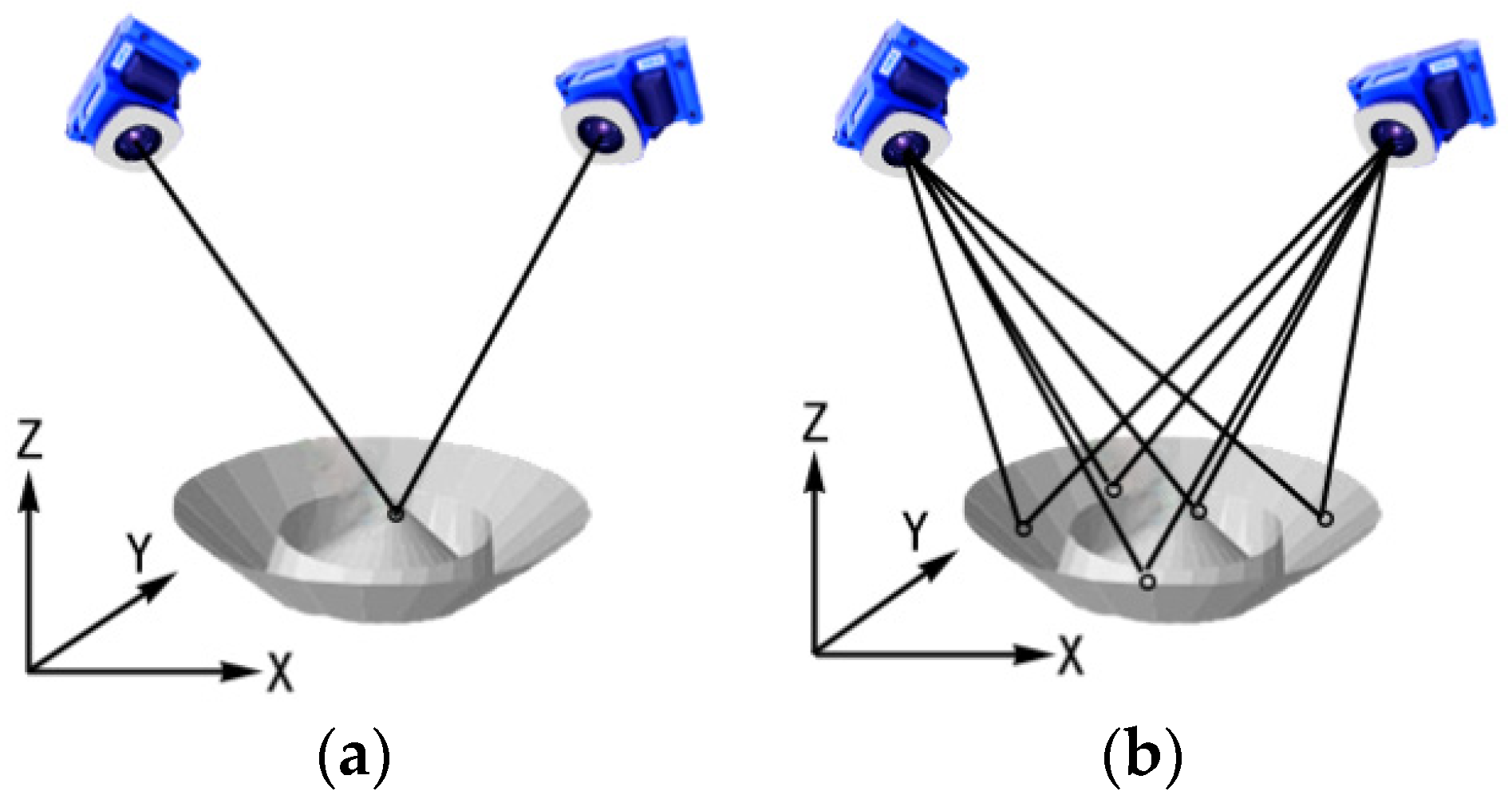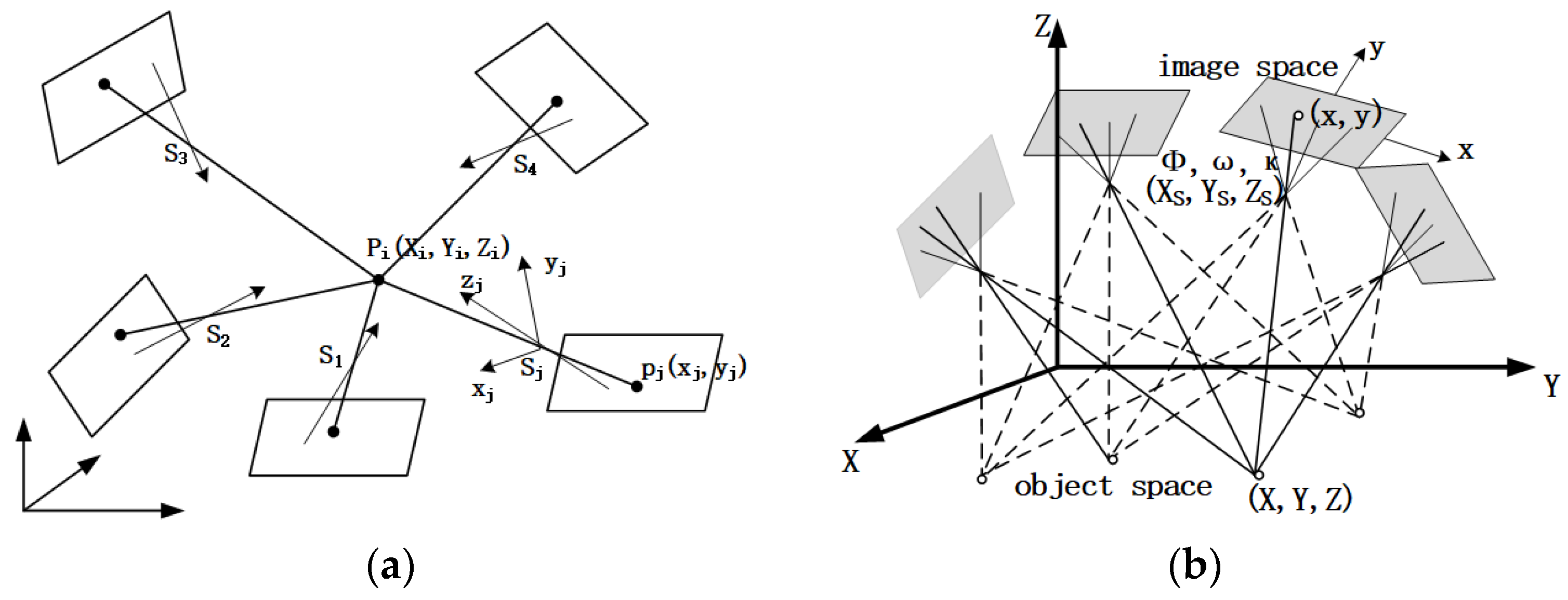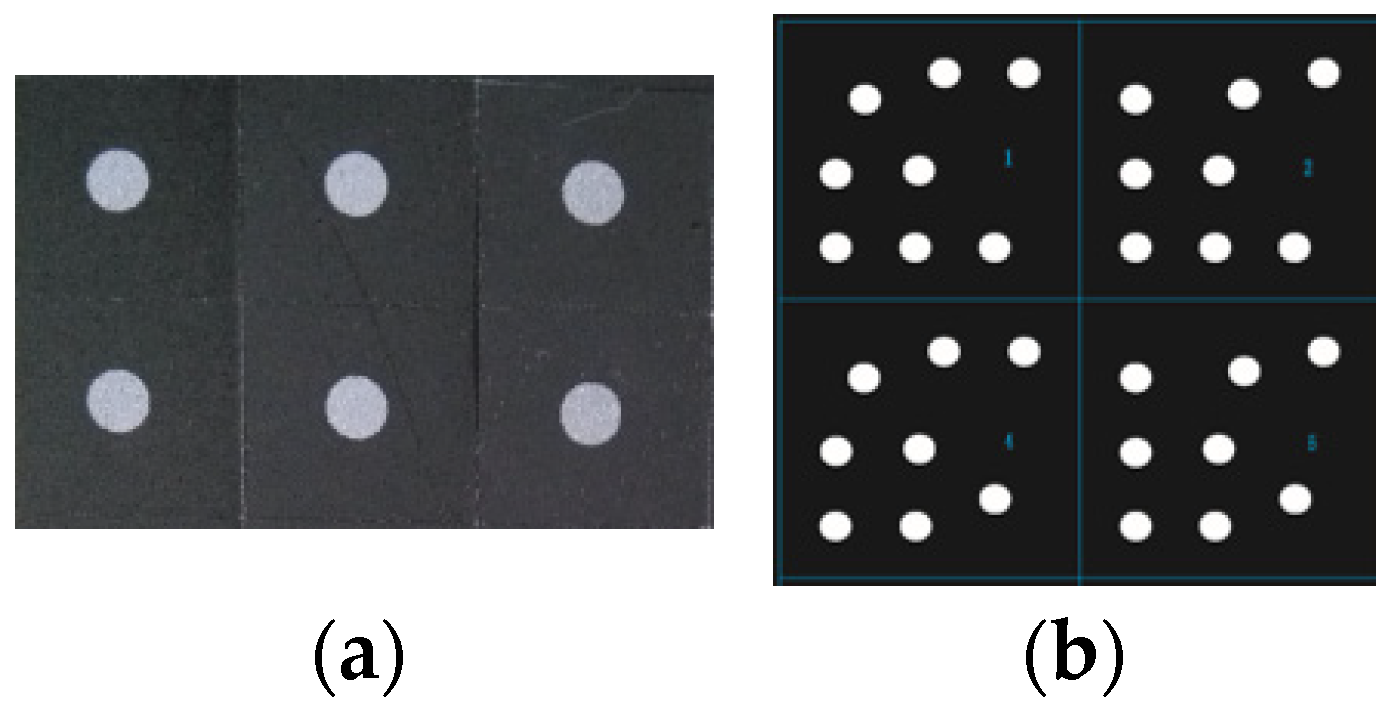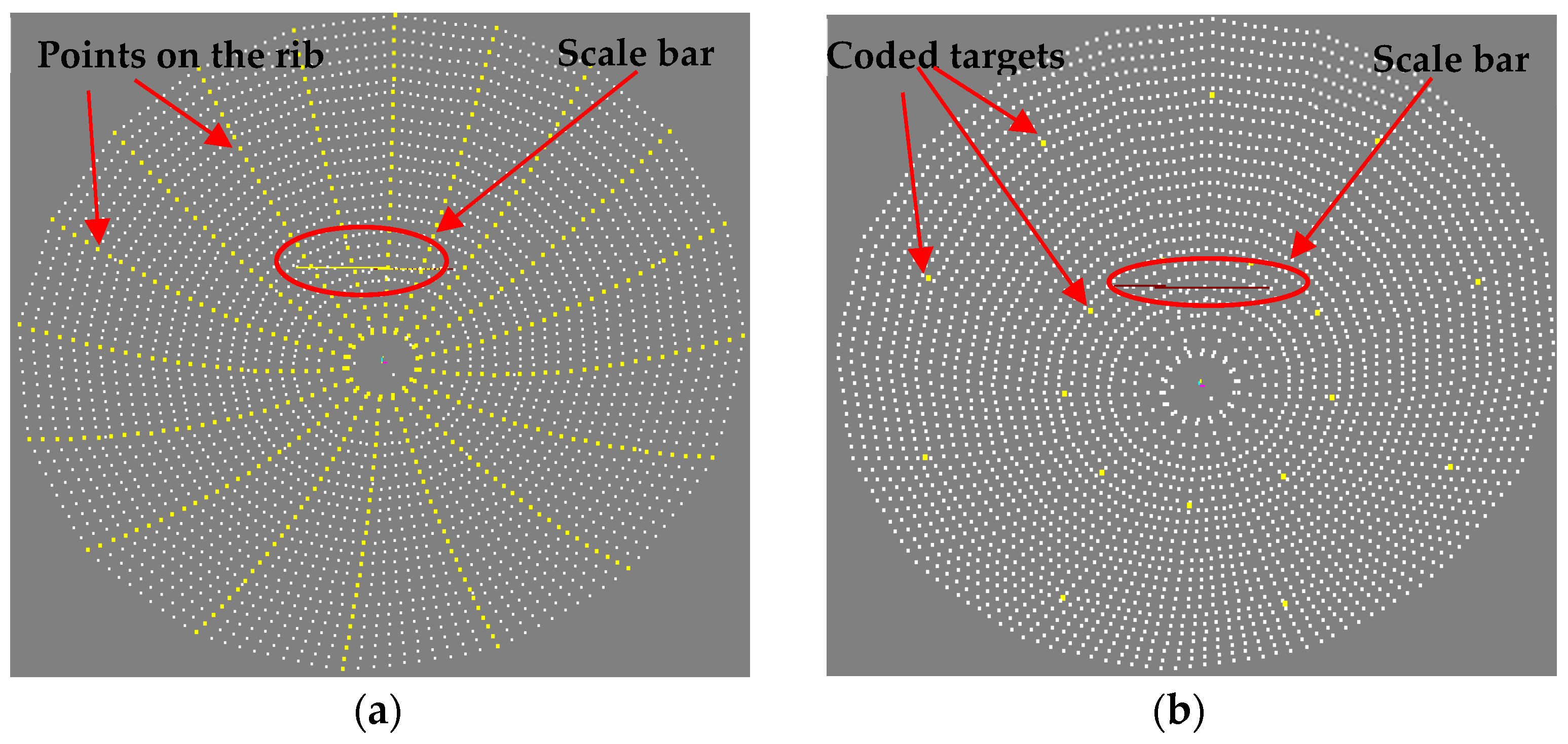Thermal Deformation Measurement of the Surface Shape of a Satellite Antenna Using High-Accuracy Close-Range Photogrammetry
Abstract
1. Introduction
2. Principles of Close-Range Photogrammetry
3. Implementation
3.1. Test Object
3.2. Measurement
- Digital camera and its protection
- 2.
- Auxiliary light source
- 3.
- Retro-reflective target (RRT)
- 4.
- Scale bar
- 5.
- Photography and mesh design
- 6.
- Close-range photogrammetry data processing
- 7.
- Post-processing of measurement data
4. Results and Analysis
4.1. Analysis of Close-Range Photogrammetry Results
4.1.1. Coordinate Repeatability Measurement Precision
4.1.2. Surface Shape Repeatability Measurement Precision
4.1.3. Scale Bar Length Measurement Error
4.2. Analysis of the Results for the Antenna Surface Shape
4.2.1. Surface Shape and Rib Precision
4.2.2. Surface Shape Deformation
5. Conclusions
Author Contributions
Funding
Institutional Review Board Statement
Informed Consent Statement
Data Availability Statement
Acknowledgments
Conflicts of Interest
References
- Jin, X.S. The development status and application of spacecraft verification and test standards. Chin. Space Sci. Technol. 2004, 24, 25–31. [Google Scholar]
- Li, Z.C.; Li, G.Y.; Wu, X.P. Review of accuracy measuring technology of antenna’s surface. Bull. Surv. Mapp. 2003, 6, 16–19. [Google Scholar]
- Okamoto, A.; Wasa, Y.; Kagawa, Y. Development of shape measurement system for hot large forgings. Kobe Steel Eng. Rep. 2007, 57, 29–33. [Google Scholar]
- Huang, G.P. Study on the Key Technologies of Digital Close Range Industrial Photogrammetry and Applications. Ph.D. Thesis, Tianjin University, Tianjin, China, 2005. [Google Scholar]
- Cui, X.M.; Ma, K.F.; Huang, G.P. Research progress and development trend analysis of modern three-dimensional industrial measuring system. J. N. Chin. Univ. Water Res. Electr. Power (Natl. Sci. Ed.) 2014, 35, 56–61. [Google Scholar]
- Li, G.Y. Principle and developing trend of non-orthogonal coordinate systems. J. Geom. 2003, 28, 4–10. [Google Scholar]
- Scaioni, M.; Barazzetti, L.; Giussani, A.; Previtali, M.; Roncoroni, F.; Alba, M.I. Photogrammetric techniques for monitoring tunnel deformation. Earth Sci. Inform. 2014, 7, 83–95. [Google Scholar] [CrossRef]
- Lee, H.; Rhee, H. 3-D measurement of structural vibration using digital close-range photogrammetry Sensor. Actuat. A-Phys. 2013, 196, 63–69. [Google Scholar] [CrossRef]
- Liu, T.S.; Burner, A.W.; Jones, T.W.; Barrows, D.A. Photogrammetric techniques for aerospace applications. Prog. Aerosp. Sci. 2012, 54, 1–58. [Google Scholar] [CrossRef]
- Yilmazturk, F.; Kulur, S.; Terzi, N. Measurement of deflections in buried flexible pipes by close range digital photogrammetry. Measurement 2010, 43, 857–865. [Google Scholar] [CrossRef]
- Luhmann, T. Close range photogrammetry for industrial applications. ISPRS J. Photogramm. 2010, 65, 558–569. [Google Scholar] [CrossRef]
- Ordonez, C.; Riveiro, B.; Arias, P.; Armesto, J. Application of close range photogrammetry to deck measurement in recreational ships. Sensors 2009, 9, 6991–7002. [Google Scholar] [CrossRef] [PubMed]
- Ozawa, S.; Fukatsu, A.; Shimizu, K. Thermal deformation measurement of onboard antenna reflector in thermal vacuum chamber by photogrammetry. In Proceedings of the 47th AIAA/ASME/ASCE/AHS/ASC Structures, Structural Dynamics, and Materials Conference, Newport, RI, USA, 1–4 May 2006. [Google Scholar]
- Wiktowy, M.; O’grady, M.; Atkins, G.; Singhal, R. Photogrammetric distortion measurements of antennas in a thermal-vacuum environment. Can. Aeron. Space J. 2003, 49, 65–71. [Google Scholar] [CrossRef]
- Meyer, C.G.; Jones, T.W.; Lunsford, C.B.; Pappa, R.S. In-vacuum photogrammetry of a 10-meter solar sail. In Proceedings of the 46th AIAA/ASME/ASCE/AHS/ASC Structures, Structural Dynamics and Materials Conference, Austin, TX, USA, 18–21 April 2005. [Google Scholar]
- Cozzani, A.; Appolloni, M.; Roure, S.; Beauvivre, S.; Casarosa, G.; Tavares, A. Measurement and calibration of a prototype miniaturised videogrammetry system in thermal-vacuum. In Proceedings of the 5th International Symposium on Environmental Testing for Space Programmes, Noordwijk, The Netherlands, 15–17 June 2004; Volume 558, pp. 331–340. [Google Scholar]
- Hill, M.D.; Herrera, A.A.; Crane, J.A.; Packard, E.A.; Aviado, C.; Sampler, H.P. Alignment measurements of the Microwave Anisotropy Probe (MAP) instrument in a thermal/vacuum chamber using photogrammetry. Proc. SPIE 2000, 4131, 255–265. [Google Scholar]
- Bouman, J.; an Oel, J.; Mueller-Stute, V.M.; Sarti, B.; Dold, J. A photogrammetry system for use in thermal vacuum testing. ESA Bull. 1995, 81, 69–76. [Google Scholar]
- Ross, A. Ka-band transmit reflector thermal distortion test and correlation. In Proceedings of the 25th ESA Antenna Workshop on Satellite Antenna Technology, Noordwijk, The Netherlands, 18–20 September 2002; pp. 395–402. [Google Scholar]
- Doyle, D.; Pilbratt, G.; Tauber, J. The Herschel and Planck space telescopes. Proc. IEEE 2009, 97, 1403–1411. [Google Scholar] [CrossRef]
- Rolo, L.F.; Paquay, M.H.; Daddato, R.J.; Parian, J.A.; Doyle, D.; de Maagt, P. Terahertz antenna technology and verification: Herschel and Planck—A review. IEEE Trans. Microwave Theory Tech. 2010, 58, 2046–2063. [Google Scholar] [CrossRef]
- Frey, H.U. Thermoelastic measurements on reflectors for telecommunication satellites. In Proceedings of the 29th International Conference on Environmental Systems, Denver, CO, USA, 12–15 July 1999. [Google Scholar]
- Lu, C.J.; Huang, G.P.; Li, G.Y. Deformation measurement of antenna reflector using photogrammetry in thermal-vacuum. Proc. SPIE 2008, 7130, 713039. [Google Scholar]
- Huang, G.P.; Ma, K.F.; Wang, C.J.; Qin, G.Q. Distortion measurement of satellite antenna in thermal vacuum. J. Astronaut. Metr. Meas. 2014, 34, 21–25. [Google Scholar]
- Jiang, S.P.; Yang, L.H.; Xu, J.; Jiang, Y. Photogrammetric measurement of deformation for satellite antennas in vacuum cryogenic environment. Opt. Tech. 2013, 39, 313–317. [Google Scholar] [CrossRef]
- Huang, G.P. Research and Development of Hybrid Surveying System Composed of Multiple Electronic Theodolite/Total Station. Master’s Thesis, Institute of surveying and Mapping of the PLA, Zhengzhou, China, 1999. [Google Scholar]
- Ma, K.F.; Huang, G.P.; Zhu, W.F.; Wang, W.F. Structural stability of simply protected camera for precision photogrammetry in high-low temperature. Fresen. Environ. Bull. 2018, 27, 6343–6350. [Google Scholar]
- Ma, K.F.; Cui, X.M.; Huang, G.P.; Yuan, D.B. Effect of light intensity on close-range photographic imaging quality and measurement precision. Int. J. Multimed. Ubiqu. Eng. 2016, 11, 69–78. [Google Scholar] [CrossRef]
- Ma, K.F.; Huang, G.P.; Hu, Q.F.; Meng, J.Z. Research on calibration methods for scale bar length in close-range photogrammetry. Ce Ca 2017, 42, 2622–2626. [Google Scholar]
- Ma, K.F.; Huang, G.P.; Hu, Q.F.; He, P.P. Surface registration algorithm for rapid detection of surface thermal deformation of paraboloid antennas. High Technol. Lett. 2018, 24, 266–271. [Google Scholar]









| Operating Condition (°C) | 20 | 60 | 20 | −20 | −60 | −20 |
|---|---|---|---|---|---|---|
| RMS of three cycles (mm) | 0.023 | 0.030 | 0.021 | 0.031 | 0.054 | 0.038 |
| 0.033 | 0.034 | 0.036 | 0.036 | 0.040 | 0.029 | |
| 0.026 | 0.035 | 0.026 | 0.028 | 0.050 | 0.028 | |
| Mean value of RMS (mm) | 0.027 | 0.033 | 0.028 | 0.032 | 0.048 | 0.032 |
| Temperature Node (°C) | 20 | 60 | 20 | −20 | −60 | −20 | 20 |
|---|---|---|---|---|---|---|---|
| RMS (mm) | 0.019 | 0.014 | 0.016 | 0.021 | 0.038 | 0.015 | 0.019 |
| Operating Condition (°C) | 20 | 60 | 20 | −20 | −60 | −20 |
|---|---|---|---|---|---|---|
| Error results of three cycles (mm) | 0.023 | 0.030 | 0.021 | 0.031 | 0.054 | 0.038 |
| 0.033 | 0.034 | 0.036 | 0.036 | 0.040 | 0.029 | |
| 0.026 | 0.035 | 0.026 | 0.028 | 0.050 | 0.028 |
| Cycles | Operating Condition (°C) | Surface Shape RMS (mm) | Rib RMS (mm) | Z Deviation RMS (mm) |
|---|---|---|---|---|
| 1 | 20 | 0.476 | 0.379 | −0.120 |
| 60 | 0.352 | 0.348 | −0.272 | |
| 20 | 0.512 | 0.420 | −0.251 | |
| −20 | 0.653 | 0.568 | −0.473 | |
| −60 | 0.817 | 0.707 | −0.542 | |
| −20 | 0.677 | 0.574 | −0.412 | |
| 2 | 20 | 0.562 | 0.442 | −0.244 |
| 60 | 0.455 | 0.331 | −0.116 | |
| 20 | 0.518 | 0.415 | −0.315 | |
| −20 | 0.655 | 0.554 | −0.490 | |
| −60 | 0.866 | 0.761 | −0.586 | |
| −20 | 0.711 | 0.618 | −0.492 | |
| 3 | 20 | 0.562 | 0.452 | −0.274 |
| 60 | 0.472 | 0.343 | −0.162 | |
| 20 | 0.533 | 0.423 | −0.329 | |
| −20 | 0.687 | 0.566 | −0.572 | |
| −60 | 0.878 | 0.742 | −0.662 | |
| −20 | 0.717 | 0.580 | −0.498 | |
| 20 | 0.556 | 0.451 | −0.294 |
| Operating Condition (°C) | 20 | 60 | 20 | −20 | −60 | −20 |
|---|---|---|---|---|---|---|
| RMS of three cycles (mm) | 0.068 | 0.184 | reference | 0.202 | 0.419 | 0.246 |
| 0.070 | 0.206 | 0.185 | 0.415 | 0.249 | ||
| 0.058 | 0.230 | 0.194 | 0.399 | 0.251 |
Disclaimer/Publisher’s Note: The statements, opinions and data contained in all publications are solely those of the individual author(s) and contributor(s) and not of MDPI and/or the editor(s). MDPI and/or the editor(s) disclaim responsibility for any injury to people or property resulting from any ideas, methods, instructions or products referred to in the content. |
© 2024 by the authors. Licensee MDPI, Basel, Switzerland. This article is an open access article distributed under the terms and conditions of the Creative Commons Attribution (CC BY) license (https://creativecommons.org/licenses/by/4.0/).
Share and Cite
Ma, K.; Huang, G.; Meng, J. Thermal Deformation Measurement of the Surface Shape of a Satellite Antenna Using High-Accuracy Close-Range Photogrammetry. Sensors 2024, 24, 4722. https://doi.org/10.3390/s24144722
Ma K, Huang G, Meng J. Thermal Deformation Measurement of the Surface Shape of a Satellite Antenna Using High-Accuracy Close-Range Photogrammetry. Sensors. 2024; 24(14):4722. https://doi.org/10.3390/s24144722
Chicago/Turabian StyleMa, Kaifeng, Guiping Huang, and Junzhen Meng. 2024. "Thermal Deformation Measurement of the Surface Shape of a Satellite Antenna Using High-Accuracy Close-Range Photogrammetry" Sensors 24, no. 14: 4722. https://doi.org/10.3390/s24144722
APA StyleMa, K., Huang, G., & Meng, J. (2024). Thermal Deformation Measurement of the Surface Shape of a Satellite Antenna Using High-Accuracy Close-Range Photogrammetry. Sensors, 24(14), 4722. https://doi.org/10.3390/s24144722







